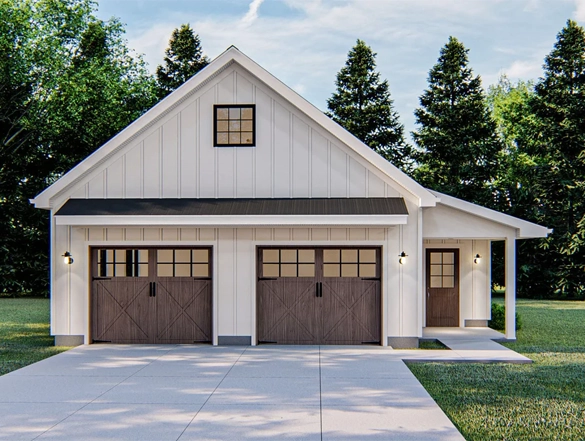Building a new garage is a fantastic way to add value, convenience, and functionality to your home. Whether you’re planning an attached garage or a detached structure, the process requires careful planning and decision-making to ensure your garage meets your needs and stands the test of time.
From selecting the right materials to understanding important features like garage door opener installation, this guide covers the top 10 things you need to know before starting your new garage construction project.
1. Understand Local Building Codes and Permits
Before breaking ground, it’s crucial to research local building codes and zoning regulations. Most cities require permits for garage construction to ensure safety and compliance with land use rules. These codes govern aspects such as:
-
Setbacks from property lines
-
Garage size and height limits
-
Electrical and plumbing requirements
-
Fire safety measures
Getting the proper permits early prevents costly delays or fines and ensures that your new garage is legally sound.
2. Decide Between Attached or Detached Garage
Choosing between an attached or detached garage is one of the first major decisions. An attached garage offers:
-
Direct access to your home
-
Shared heating or cooling benefits
-
Easier snow removal or weather protection
A detached garage, on the other hand, offers:
-
More design flexibility
-
Reduced noise inside the home
-
Potential for additional workshop or storage space
Consider your property layout, budget, and lifestyle to make the best choice.
3. Plan Your Garage Size and Layout
The size of your garage impacts both its functionality and cost. Common garage sizes include:
-
One-car garage: roughly 12’ x 20’
-
Two-car garage: roughly 20’ x 20’ to 24’ x 24’
-
Three-car or larger garages for additional vehicles or storage
Plan for extra space if you want room for storage shelves, a workbench, or bicycles. When designing your layout, think about:
-
Door placement
-
Window locations for natural light
-
Entry points to the house or yard
4. Choose Quality Materials and Construction Techniques
Investing in durable materials and professional construction ensures your garage will last for years with minimal maintenance. Some popular materials include:
-
Concrete or asphalt for the driveway and floor
-
Wood framing for a traditional look
-
Steel framing for durability and fire resistance
-
Vinyl or wood siding to match your home’s exterior
Be sure to discuss materials with your builder to align with your budget and desired aesthetic.
5. Don’t Overlook Insulation and Ventilation
A well-insulated garage is more comfortable and energy-efficient, especially if you use the space for more than parking. Insulation helps:
-
Regulate temperature
-
Prevent moisture buildup
-
Reduce noise
Proper ventilation is also important to prevent mold and keep the air fresh. Consider windows, vents, or even an exhaust fan.
6. Choose the Right Garage Door and Plan for Garage Door Opener Installation
The garage door is a major visual and functional element. Popular garage door materials include steel, wood, and aluminum, each with different costs and maintenance requirements.
Equally important is planning for garage door opener installation. An automatic garage door opener provides:
-
Convenience with remote or smart controls
-
Enhanced security features
-
Safety sensors to prevent accidents
Make sure your garage door is compatible with the opener you choose, and hire a professional for the installation to guarantee smooth, safe operation.
7. Include Adequate Lighting and Electrical Outlets
Good lighting improves safety and usability, especially if you use the garage as a workshop or storage space. Plan for:
-
Overhead LED lights for general illumination
-
Task lighting over workbenches or storage areas
-
Exterior lighting for security
Install multiple electrical outlets in accessible locations to power tools, chargers, and the garage door opener installation system.
8. Think About Storage and Organization
Building a garage gives you an opportunity to improve home organization. Consider incorporating:
-
Built-in shelving or cabinets
-
Overhead racks for seasonal items
-
Pegboards or hooks for tools and garden equipment
Planning your storage during construction makes it easier and more cost-effective than retrofitting later.
9. Plan for Drainage and Water Management
Proper drainage is essential to keep your garage dry and prevent damage. Ensure your site grading directs water away from the foundation. Installing:
-
A drainage system or trench drain at the garage entrance
-
Gutters and downspouts connected to stormwater management systems
These measures will protect your garage floor and structure from water damage over time.
10. Budget for Unexpected Costs and Maintenance
Finally, set a realistic budget that includes not just construction costs but also finishing touches like garage door opener installation, permits, inspections, and landscaping. It’s wise to allocate 10-15% extra for unexpected expenses.
Remember that regular maintenance—such as inspecting your garage door opener, sealing cracks, and cleaning gutters—will help keep your garage in top condition.
Conclusion
Building a new garage is a major project that requires careful consideration of many factors. From complying with local regulations and choosing the right materials to prioritizing features like garage door opener installation, being prepared ensures your new garage will be a valuable, functional addition to your home.
By following these top 10 tips, you’ll be well-equipped to design and build a garage that fits your lifestyle, enhances your property, and provides lasting convenience and security.
Frequently Asked Questions (FAQs)
1. How important is professional garage door opener installation?
Professional garage door opener installation is crucial for safety, reliability, and optimal performance. Experts ensure correct wiring, alignment, and calibration of sensors, reducing the risk of accidents and mechanical issues.
2. Can I install a garage door opener myself?
While some experienced DIYers may attempt it, garage door opener installation involves electrical work and safety components best handled by professionals. Improper installation can cause malfunctions or accidents.
3. How much does garage door opener installation typically cost?
Costs vary depending on the opener type and complexity but expect to pay between $200 to $500 for professional garage door opener installation, including labor and basic equipment.

